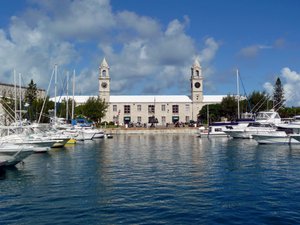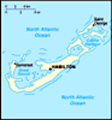Advertisement
Published: August 3rd 2022

 Clock Tower Mall
Clock Tower Mall
Great Eastern Storehouse at the Royal Naval Dockyard. Adaptive reuse as Clock Tower Mall Construction of the Royal Naval Dockyard began in 1809. It remained an active naval base until 1951. One of the towers show the time and the other the time of high tide. Repurposed from 1982 as a museum, cruise centre and tourist attraction. Sandys Parish, Bermuda.
P1180105p1We planned to spend our third day in Bermuda around the Dockyard in Sandys Parish (Ireland Island) and take the bus as far as the Fort Scaur site. All started well. We were off the ship before 9:00 a.m. and headed for the Bermuda Craft Market. But, before we could get there, a huge rainstorm came up! This wasn't a light squall like we'd experienced in Hamilton, it was a downpour! We were drenched! There was nothing to do but to head back to the ship to change clothes. As we headed for our cabin, our steward spotted us and handed us extra towels to dry off. Very nice! By the time we dried off, changed clothes, and put our wet clothes up to dry, we'd lost an hour. That was the end of the plan to visit Fort Scaur, but there was still the whole Dockyard to explore.
The Royal Naval Dockyard, or HM Dockyard, Bermuda, was built beginning around 1800. The site eventually included fortified defensive positions, storehouses for provisioning ships, a garrison of Army troops, and a floating drydock. (The British invasion of Washington, DC, during the War of 1812 was launched from the Dockyard.) The Royal

 Moongate
Moongate
Bermuda Moongate at the Dockyard. Moongates have been a Bermuda tradition since 1860. A sea captain is said to have been inspired by a moongate he saw in China. More than 40 are located around the islands.
P1180275Navy abandoned the Dockyard in 1958. Bermuda did not quite know what to do with the facilities and much of the site fell into disrepair. The Casemate Barracks were used a prison for a time. Then, the site was repurposed as a historical site, a cruise terminal, and a Bermuda marketplace oriented towards visitors. The deepwater port could handle the larger cruise ships of today, which could no longer dock at St. George and found Hamilton increasingly difficult to negotiate.
Visitors are greeted at the site by a Bermuda Moongate. The first Moongates were brought from China in the 19th century and have become a Bermuda tradition and symbol of good luck. This time, we passed through the Dockyard's Moongate with no rain! To the left, a path led between the Bermuda Craft Market and the forbidding castle-like Keep Yard. Surrounded by a moat, the Keep Yard was the principal defensive installation protecting the Dockyard from attack. It is now the National Museum of Bermuda. (Formerly known as the Bermuda Maritime Museum.) We wanted to have time to see the museum, so went there first. The Keep Yard itself with its munitions buildings and gun positions form an outdoor

 Commissioner's House
Commissioner's House
Royal Naval Dockyard: Commissioner's House. The prefabricated iron building was among the first of its kind. It now houses exhibits of the National Museum of Bermuda. Built in 1827.
P1180494p1exhibit. All around are large blocks with an arrow design carved into them. I learned these are called Broad Arrows and are traditional British property markers.
The National Museum of Bermuda was formed in 2009 with the addition of the Casemates Barracks and ramparts to the existing Bermuda Maritime Museum. The museum contains exhibits on Bermuda history, slavery, maritime history and tourism. A large mural shows scene's from Bermuda's history from the wreck of
Sea Venture to the present. The Portuguese were the first to have reportedly landed on Bermuda, in the 16th century, but they did not stay. Bermuda had no indigenous peoples.
They were survey or boundary markers in the Keep Yard used to delineate Royal property. We walked around this before entering the central Commissioner's House where the indoor exhibits are housed. The Commissioner's House was a prefabricated iron structure, fabricated in Britain and set up in Bermuda. The three floors contain exhibits on Bermuda's history, colonization, peoples, British and American Naval presence, and even the story of cruising and tourism in Bermuda! Once can learn about the former Bermuda Railway and the flying boats that provided tourist air service to Bermuda from New York

 Entrance to the Commissioner's House
Entrance to the Commissioner's House
Entrance to the Commissioner's House. National Museum of Bermuda.
P1180594in the 1930s.
It was now time for lunch. Across the way was the Frog and Onion Pub where we enjoyed traditional British pub fare. I had Bangers and Mash. The Frog and Onion is in the former Cooperage Building, now the Bermuda Arts Centre. The Arts Centre showcases the work of Bermuda crafters. There are foodstuffs, jewelry, art works, books, and a variety of other handmade goods for sale.Outside is the large Victualling Yard. It is lined by the two former food storehouses but in 1853. (The Cooperage, now the Craft Market, was where food storage barrels were made.) The storehouses are empty, but the area is a nice green square. On the other side are residences, originally for officers, but private residences today. A path here lead to the Dockyard Glassworks, housed in an old building. The Glassworks is a working glassblowing shop and demonstrations are given regularly. Also here is the Bermuda Run Cake Factory. We bought glassware for Christmas gifts and a rum cake to take back for Thanksgiving.
The rest of the Dockyard has more shops, including a pharmacy where some medicinal items that might require a prescriptions in other countries can be

 The Keep
The Keep
The Keep. Royal Naval Dockyard. The Keep contained the gunpowder magazines, the Commissioner's House and gun emplacements. Ramparts surrounding the Keep Yard, Royal Naval Dockyard. The Keep was built to guard the entire naval base against attack and features seven irregular bastions and ramparts.
P1180573p1bought over-the-counter.The Great Eastern Storehouse has twin 100-foot clock towers and is one of the most recognizable landmarks in Bermuda. One of the clocks kept the time, while the other single-hand clock was a Tide Clock. It told mariners the time of the next high tide. The building has been refashioned as the Clock Tower Mall with a variety of jewelry, clothing, and souvenir shops inside.
It was now getting on towards 4:00 p.m. and we headed back to the ship for the 5:00 p.m. sailing.
Advertisement
Tot: 0.065s; Tpl: 0.013s; cc: 10; qc: 30; dbt: 0.0297s; 1; m:domysql w:travelblog (10.17.0.13); sld: 1;
; mem: 1.1mb























